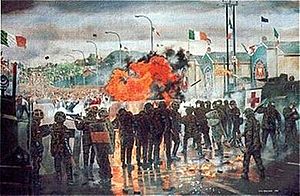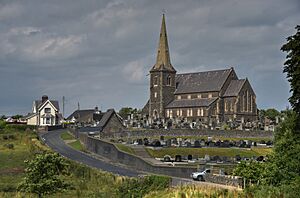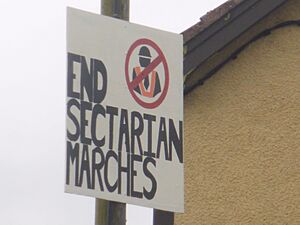1997 Northern Ireland riots facts for kids
From 6 to 11 July 1997, there were big protests, serious riots, and gun battles in areas of Northern Ireland where most people were Irish nationalists. These Irish nationalists, sometimes helped by the Provisional Irish Republican Army (IRA), fought against the Royal Ulster Constabulary (RUC) (the police force) and the British Army.
The protests and violence started because the authorities decided to let the Orange Order march through a Catholic neighborhood in Portadown. The Orange Order is a Protestant group that supports Northern Ireland staying part of the UK. Irish nationalists were very angry about this decision. They were also upset by how the RUC treated people protesting against the march. This march had been a cause of conflict for many years, known as the Drumcree conflict.
This period was the last time there was widespread violence in Northern Ireland before the Good Friday Agreement was signed in April 1998. Rioters threw stones and petrol bombs at the police and soldiers hundreds of times. IRA members used automatic rifles and grenades. The security forces fired over 2,500 plastic bullets at the rioters and exchanged gunfire with the IRA. More than 100 regular people and 65 police or soldiers were hurt. Many people complained about police brutality. A 13-year-old boy went into a coma after being hit in the head by a plastic bullet.
Many cars were stolen, set on fire, and used to block roads in Belfast and other towns like Newry, Armagh, and Dungannon. The RUC and British Army had to completely leave some nationalist areas of Belfast. The Provisional IRA's involvement in these clashes was their last major action in their 27-year campaign. The group announced its last ceasefire on 19 July.
Quick facts for kids 1997 riots in Northern Ireland |
|||||||
|---|---|---|---|---|---|---|---|
| Part of the Troubles | |||||||
 "Drumcree, The Garvaghy Road July 1997" by military artist David Rowlands, oil on canvas, 91cm x 61 cm, painting owned by the 1st Battalion (The Cheshires) The Mercian Regiment which depicts British soldiers during the rioting on Garvaghy Road |
|||||||
|
|||||||
| Belligerents | |||||||
|
Irish nationalist rioters Supported by:
|
|||||||
| Commanders and leaders | |||||||
| Kevin McKenna (IRA) | Ronnie Flanagan (RUC) Rupert Smith (BA) |
||||||
| Casualties and losses | |||||||
| 1 civilian killed over 100 people injured, 117 arrested |
62 constables injured, at least 3 soldiers injured, some armoured vehicles badly damaged or destroyed |
||||||
|
|
|||||||
Contents
Why the Riots Happened
The Orange Order is a Protestant group that has a tradition of marching. They believe they should be allowed to march their usual route to and from Drumcree Church every July. They had marched this route since 1807. Back then, the area was mostly farmland. But today, most of this route goes through a part of Portadown that is mainly Catholic and Irish nationalist.
The people living there wanted the march to go a different way. They felt the march was "triumphalist," meaning it was meant to show off power over them. They compared it to a Ku Klux Klan march through an African American neighborhood.
History of the Drumcree March
The march was first banned in 1832, but the Orange Order ignored the ban. A local official wrote in 1835 that Orangemen were "insulting" and "outraging" peaceful residents. They would parade, play party music, fire shots, and use offensive words. They even marched past the Catholic church on purpose, even though it was out of their way.
When the Troubles began in 1969, this disagreement became much worse. The local population also changed, making the divide between groups stronger. In 1987, Orangemen were stopped from marching along Obins Street. This was because their march had caused serious riots two years in a row. However, they were still allowed to march along Garvaghy Road, another main road in the Catholic area.
In 1995, residents formed the Garvaghy Road Residents Coalition (GRRC). Their goal was to get the march moved away from Garvaghy Road. The conflict grew that July when residents blocked Garvaghy Road for two days. Orangemen and their supporters fought with the Royal Ulster Constabulary (RUC). Eventually, the residents were convinced to clear the road, and the march went ahead.
The July 1996 march was banned from Garvaghy Road. Thousands of Orangemen and their supporters gathered at Drumcree. They had a three-day standoff with the RUC. They held large protests and attacked police and Catholics across Northern Ireland. A loyalist group, the Loyalist Volunteer Force (LVF), shot and killed a Catholic taxi driver. They also threatened more attacks. Because of this, the ban was lifted. Police used force to remove nationalist protesters from Garvaghy Road and made the march go through. This led to days of riots in Catholic/nationalist areas of Northern Ireland. One protester was crushed to death by a British Army armored vehicle in Derry.
The 1997 Drumcree Parade
In June 1997, the government official in charge of Northern Ireland, Mo Mowlam, secretly decided to let the march happen. However, in the days before the march, she said no decision had been made. She met with the Irish Prime Minister, Bertie Ahern, who said that allowing the march alone would be a mistake. The RUC and the Northern Ireland Office said they would announce their decision a few days before the march.
Documents released later showed that on June 9, the RUC asked for heavy equipment to remove roadblocks. The British Army also measured Garvaghy Road to possibly put up barriers. As the parade day got closer, thousands more British troops arrived in Northern Ireland. Thousands of people left the area, fearing more violence. Residents of Garvaghy Road set up a "peace camp" along the road. The Loyalist Volunteer Force (LVF) threatened to kill Catholic civilians if the march was not allowed. The Ulster Unionist Party also threatened to leave the peace talks. On July 4, sixty families had to leave their homes on Garvaghy Road because of a loyalist bomb threat.
On Sunday, July 6, at 3:30 AM, 1,500 soldiers and riot police arrived in 100 armored vehicles. They took control of Garvaghy Road so the marchers could pass. This led to clashes with about 300 protesters who sat down on the road. Police forcibly removed them. Rosemary Nelson, the lawyer for the residents, was verbally and physically abused by officers. Some officers said residents mocked them about the killing of two police colleagues. From then on, the road was blocked by armored vehicles, and residents were trapped in their homes. Since residents could not reach their Catholic church, local priests held an outdoor mass in front of soldiers and armored vehicles. The police chief, Ronnie Flanagan, said the march was allowed to avoid violence from loyalists. The parade marched along Garvaghy Road at noon that day. After it passed, the security forces started to leave, and serious rioting began. Hundreds of nationalists attacked them with stones, bricks, and petrol bombs. About 40 plastic bullets were fired, and about 18 people went to the hospital.
What Happened After
By July 9, an RUC report said that 60 RUC officers and 56 civilians were hurt. Also, 117 people were arrested. There were 815 attacks on the police and army, 1,506 petrol bombs thrown, and 402 cars stolen. The RUC had fired 2,500 plastic bullets. Other reports say over 100 people were injured in total.
The last IRA action happened on July 12. An improvised mortar bomb landed close to the RUC/British Army base in Newtownhamilton. People also set fire to Orange halls in Warrenpoint and Rasharkin. A local politician, Paul Butler, claimed to have found a "British Army spy post" in Twinbrook, Belfast. He said it was used during the riots to watch people's movements.
The violence calmed down on July 10. This was when the Orange Order decided on their own to change the routes of six parades. The next day, Orangemen and residents agreed to cancel another march in Newtownbutler. In Pomeroy, nationalist residents blocked a return parade with their own protest. Marches in Newry and Lower Ormeau were completely cancelled. This decision by the Orange Order was very unusual in its 202-year history. A member of the Order said it was a "bitter pill to swallow," but they were told that any other decision would have meant "civil war."
At the same time, on July 9, the British government told Sinn Féin (a political party linked to the IRA) that if the IRA stopped fighting again, Sinn Féin leaders could meet with government ministers. A week later, Gerry Adams and Martin McGuinness (leaders of Sinn Féin) asked the IRA to restart their 1994 ceasefire. The IRA announced they would stop fighting on July 19. A famous photograph called The Last Gunman, showing an IRA man firing a rifle on Ormeau Road, became a well-known image from the Troubles.
The Orange Order has not marched through Garvaghy Road in Portadown since 1997. The Parades Commission has forbidden it since 1998.
Images for kids
See Also
- 1969 Northern Ireland riots
- 1996 Derry riots
- Drumcree conflict






